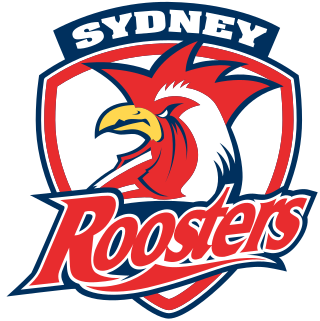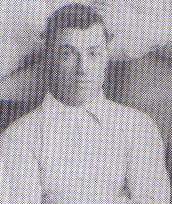
The Sydney Roosters are an Australian professional rugby league football club based in the Eastern Suburbs and inner Sydney including the CBD. The club competes in the National Rugby League (NRL) competition. The Roosters have won fifteen New South Wales Rugby League (NSWRL) and National Rugby League titles, and several other competitions. First founded as the Eastern Suburbs District Rugby League Football Club (ESDRLFC), it is the only club to have played in every season at the elite level, and since the 1970s has often been dubbed the glamour club of the league. The Sydney Roosters have won 15 premierships, equal to the record of the St George Dragons. Only the South Sydney Rabbitohs have won more premierships. The club holds the record for having won more matches than any other in the league, the most minor premierships and the most World Club Challenge trophies. The Sydney Roosters are one of only two clubs to finish runners-up in their inaugural season. Currently coached by Trent Robinson and captained by James Tedesco, the Roosters play home games at the Sydney Football Stadium.
The 1908 NSWRFL season was the inaugural season of the New South Wales Rugby Football League's premiership, Australia's first rugby league football club competition, in which nine clubs competed from April till August 1908. The season culminated in the first premiership final, for the Royal Agricultural Society Challenge Shield, which was contested by Eastern Suburbs and South Sydney. In 1908 the NSWRFL also assembled a New South Wales representative team for the first ever interstate series against Queensland, and towards the end of the season, the NSWRFL's leading players were absent, having been selected to go on the first Kangaroo tour of Great Britain.
The 1914 New South Wales Rugby Football League premiership was the seventh season of Sydney's top-grade rugby league football club competition, Australia's first. Eight teams from across the city contested during the season. The 1914 season's gate receipts totalled £24,072, which was £7,038 more than the previous season's.
Robert Emmett Honan is an Australian former rugby union and rugby league footballer who played in the 1960s and 1970s – a dual code rugby international.
Ronald James Lisle was an Australian rugby union and rugby league player and a dual code rugby international. He represented the Wallabies in 4 tests in 1961 and the Australia national rugby league team in 13 matches on the 1963 Kangaroo tour.
Horace Miller (1882–1967) was an Australian rugby league footballer in the New South Wales Rugby Football League premiership. He played as a wing with the Eastern Suburbs club in 1908 and 1909, the first years of the new code.
John S. H. Rosewell was an Australian rugby union and pioneer professional rugby league footballer and represented his country at both sports – a dual-code international.

Arthur Stephen "Ash" Hennessy was an Australian pioneer rugby league identity. He was a seminal figure in the creation of the South Sydney Rabbitohs for whom he played and later coached. He was a state and national representative hooker/forward and was the first captain of the Australian national rugby league team. He played for New South Wales in the first rugby match run by the newly created 'New South Wales Rugby Football League' which had just split away from the established New South Wales Rugby Football Union. He later coached at club, state and national representative levels.
Frederick Fry (1885-1963) was a rugby league footballer in the New South Wales Rugby League (NSWRL) competition in the foundation year of the sport in Australia. Fred Fry was a fullback in the Eastern Suburbs club's first ever match, on Easter Monday, 20 April 1908. William Fry's Player Number with the Sydney Roosters is 6.
Robert Henderson Graves was a pioneer Australian rugby league and rugby union player and one of his country's first dual-code internationals. He was a versatile forward for the Australia national team. He played in 6 Tests between 1908 and 1909, as captain on 1 occasion. In 1907 he played for New South Wales in the first rugby match run by the newly created 'New South Wales Rugby Football League' which had just split away from the established New South Wales Rugby Football Union.
Bernie Purcell (1928–2001) was an Australian rugby league premiership winning footballer and coach. He was a goal-kicking second-row forward of the 1950s for the South Sydney Rabbitohs, the Australian national representative and the New South Wales state sides.
The 1928 New South Wales Rugby Football League premiership was the twenty-first season of Sydney’s top-level rugby league club competition, Australia’s first. During the season, which lasted from April until September, nine teams from across the city contested the premiership, culminating in a final between Eastern Suburbs and South Sydney.
The 1932 New South Wales Rugby Football League premiership was the twenty-fifth season of Sydney’s top-level rugby league competition, Australia’s first. During the season, which lasted from April until September, eight teams from across the city contested the premiership, culminating in South Sydney’s victory over Western Suburbs in the final.
The 1933 NSWRFL season was the twenty-sixth season of Sydney’s professional rugby league club competition, Australia’s first. Eight teams from across the city contested the New South Wales Rugby Football League premiership during the season, which lasted from April until September, and culminated in Newtown’s victory over St. George in the final.

Howard Hallett (1890–1970) was an Australian rugby league footballer and coach for South Sydney of the New South Wales Rugby League premiership. Hallett primarily played at fullback. He represented for New South Wales and Australia and is considered one of the nation's finest footballers of the 20th century

Wiliam A. Cann (1882–1958) was an Australian rugby league footballer who played in the 1900s who later wrote for The Sydney Morning Herald. A New South Wales state and Australia national representative lock forward, he has been named as one of the nation's finest footballers of the 20th century. Cann played his club football for South Sydney with whom he won the 1914 NSWRFL Premiership. In 1907 he played for New South Wales in the first rugby match run by the newly created 'New South Wales Rugby Football League' which had just split away from the established New South Wales Rugby Football Union. Cann was also a long-term administrator at Souths and a football journalist.
Albert Bentley "Son" Burge was an Australian rugby union lock who played with the Souths rugby union club in Sydney and at the age of nineteen was selected for the Australian national team in two Tests against New Zealand in 1907.

Peter Harold Boyne Burge was an Australian rugby footballer and coach. He represented his country in both rugby league and rugby union. The eldest of the four Burge brothers, Peter was one of the first Australian dual-code rugby internationals.
Andy Morton (1882-1950) was a pioneering Australian rugby league footballer who played in the 1900s and 1910s. An Australia international and New South Wales state representative backline player, he played club football for North Sydney and in England for Hull FC.
Jack Cochrane also known as "John Cochrane" was an Australian rugby league footballer who played in the 1900s. He played for South Sydney in the New South Wales Rugby League (NSWRL) competition. Cochrane was a foundation player for South Sydney playing in the club's first ever game.






